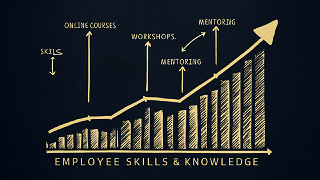
Upskill and Thrive
In today’s rapidly evolving business world, the only constant is change. With technological advancements, shifting consumer preferences and global economic trends, businesses must adapt to survive and thrive.
One of the most crucial aspects of adaptation is ensuring that your Workforce is Equipped with the Skills and Knowledge needed to navigate these changes effectively. This is where upskilling comes into play.

The Importance of Upskilling
Upskilling refers to the process of teaching employees new skills or enhancing existing ones to keep pace with changing job requirements and industry trends.
In a world where automation and artificial intelligence are reshaping traditional job roles, upskilling has become essential for both employees and employers.
- Staying Relevant in a Competitive Market
In a competitive job market, employees who possess relevant, up-to-date skills are more likely to stand out to employers.
By upskilling, employees can future-proof their careers and remain competitive in their field.
- Driving Innovation and Growth
Upskilling empowers employees to innovate and adapt to new technologies and methodologies. This, in turn, drives innovation within the organization and fosters a culture of continuous improvement.
- Increasing Employee Engagement and Retention
Investing in employee development through upskilling demonstrates a commitment to their professional growth and success. This can lead to higher levels of employee satisfaction, engagement and retention.

Strategies for Implementing Upskilling Programs
To effectively future-proof your workforce through upskilling, it’s essential to develop a comprehensive strategy that aligns with your business goals and objectives.
Here are some key strategies to consider.
- Assessing Skills Gaps
Conduct a thorough assessment of your organization’s current skill sets and identify areas where upskilling is needed. This can be done through employee surveys, performance evaluations and consultations with department heads.
- Setting Clear Objectives
Define clear objectives for your upskilling program, such as improving productivity, enhancing customer service or accelerating innovation. Setting specific goals will help measure the effectiveness of the program and ensure alignment with business priorities.
- Providing Targeted Training and Development
Offer targeted training and development opportunities that address the identified skills gaps. This may include workshops, seminars, online courses, mentoring programs or on-the-job training.
- Leveraging Technology
Harness the power of technology to deliver upskilling programs efficiently and cost-effectively. Online learning platforms, virtual reality simulations and mobile apps can provide flexible and accessible learning opportunities for employees.
- Encouraging Continuous Learning
Promote a culture of continuous learning and professional development within your organization. Encourage employees to take ownership of their learning journey and provide support and resources to facilitate ongoing skill development.

Case Studies
Many American companies understand the crucial role upskilling plays in staying competitive in a rapidly evolving business panorama. Here are some inspiring real-life examples.
- PepsiCo: As part of their pep+ (PepsiCo Positive) strategy, PepsiCo is working to provide meaningful jobs and growth opportunities for their associates. PepsiCo empowers them to make a positive impact at work, at home and in their local communities. PepsiCo furthers their careers through increased access to skill development, higher education, broadening experiences and new job roles that offer growth opportunities to everyone at every stage.
- Amazon: In September 2021, Amazon committed $1.2 billion to provide 300,000 employees with access to education and skills training programs—including college tuition for front-line employees—through 2025 as part of Amazon’s Upskilling 2025 pledge.
- Walmart: Recognizing the evolving retail world, Walmart launched “Live Better U” a degree completion program in partnership with Guild Education. It covers tuition and fees for employees pursuing associates or bachelor’s degrees in business, supply chain and technology – fields crucial for their future. This initiative aims to build a more qualified and engaged workforce.
- IBM: IBM launched “New Collar” to address IT skills gaps. The program provides on-the-job training, mentoring and certifications in areas like cybersecurity and cloud computing. This initiative has helped upskill and reskill thousands of employees, keeping IBM at the forefront of the IT industry.
- Delta Air Lines: To foster leadership within its ranks, Delta created the “Delta Leadership Academy.” This intensive program uses coaching, simulations and project-based learning to equip high-potential employees with critical leadership skills. This investment ensures a continuous pipeline of qualified leaders for the company’s future.

Conclusion
In today’s fast-paced business environment, upskilling is no longer just an option – it’s a necessity. By investing in the development of your workforce, you can future-proof your business, drive innovation and stay ahead of the competition.
Whether it’s through targeted training programs, leveraging technology or fostering a culture of continuous learning, Upskilling is the Key to Unlocking the Full Potential of Your Workforce and ensuring long-term success.

Frequently Asked Questions
Question 1: Why is upskilling important for businesses?
Answer: Upskilling is crucial for staying competitive, driving innovation and adapting to changing market demands.
Question 2: What are key strategies for implementing upskilling programs?
Answer: Strategies include assessing skills gaps, setting clear objectives, providing targeted training, leveraging technology and fostering a culture of continuous learning.
Question 3: How does upskilling benefit employees and employers?
Answer: Upskilling boosts employee satisfaction, engagement and career advancement while enhancing productivity, innovation and competitiveness for employers.
Question 4: Can you give an example of successful upskilling implementation?
Answer: Grow with Google: This initiative by Google provides free digital skills training to individuals and businesses. It includes online courses, workshops and certification programs in various areas like marketing, web development, data analytics and cloud computing.
One Comment
Leave A Comment
Categories
- Business Growth Strategies (143)
- Customer Experience and Retention (23)
- Digital Marketing and SEO (29)
- Financial Planning and Investment (26)
- Leadership and Team Management (28)
- Personal Development and Productivity (71)
- Technology and Innovations (52)
- USA Biz Growth (1)
Subscribe To Our Newsletter














Thanks for sharing. I read many of your blog posts, cool, your blog is very good.